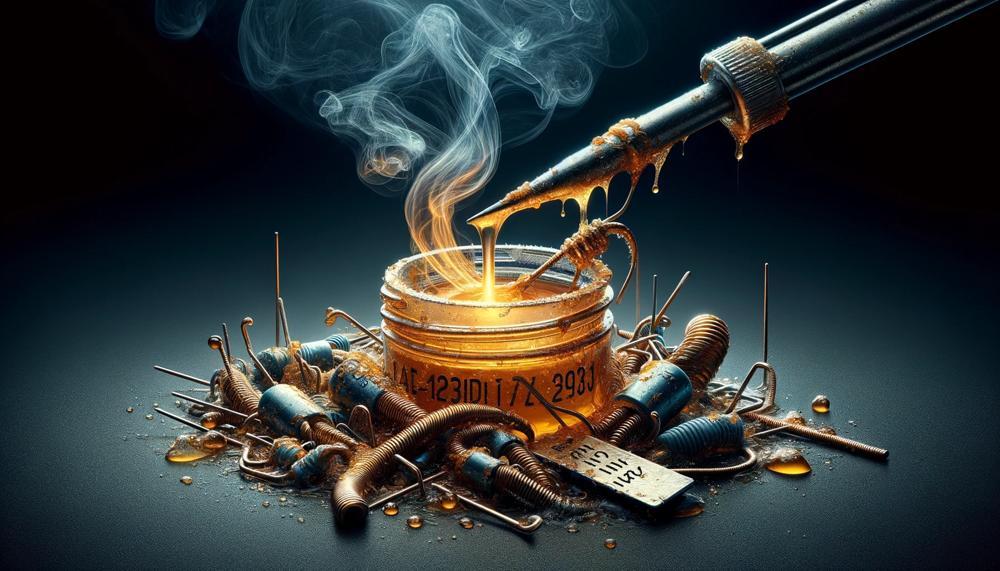In the intricate dance of metal joining and circuit creation, soldering flux plays the unsung hero, ensuring clean, corrosion-free connections that stand the test of time. However, much like the finest spices in a chef’s arsenal, this essential soldering companion doesn’t last forever. Welcome to our deep dive into the world of soldering flux and its shelf life—a guide that promises not only to enlighten but also to engage.
As we peel back the layers of this seemingly straightforward substance, we uncover a realm where chemistry meets craftsmanship. Whether you’re a seasoned electrical engineer, a hobbyist piecing together your latest project, or somewhere in between, understanding the longevity of your soldering flux is crucial. After all, the success of your soldering endeavors might just hinge on it.
So, does soldering flux go bad?
Most flux has a relatively short shelf life and may become unusable when it reaches its expiration date. However, some say that flux can be resistant to aging for the human-life timescale, and that gel flux can keep almost indefinitely in the fridge. Some manufacturers list an expiration date, and the flux core may go bad near the tip if the solder wire is left exposed to open air. However, some people have reported that the solder works fine several decades later if kept in a sealed bag.
Proper storage can extend the usability of flux. For example, you can put a needle through the “LUER” tip to prevent it from clogging up. You can also test a few assemblies for printing and reflow characteristics. If it prints well and solders normally, then it is fully functional and has formed reliable solder joints.
Liquid and solid resin flux shouldn’t go bad, but gel flux can go bad at room temperature. More complex, paste-like or liquid varieties may or may not be in good shape after 10 or 20 years.
So, let’s get started.
Contents
Signs of Expired Flux
When it comes to the craft of soldering, the state of your flux can make or break the success of your projects. Spotting the signs of expired or deteriorating flux is not just about ensuring strong solder joints; it’s about safeguarding the integrity of your work. Here’s what you need to keep an eye out for:
| Sign | Description | Why It Matters |
| Change in Consistency | Flux that’s gone off might turn unusually thick, sticky, or even solidify, diverging from its original state. | Affects ease of application and can hinder the flux’s ability to clean the metal surface properly. |
| Discoloration | Any noticeable change in color could be a signal that the flux is past its prime. | Color change often indicates chemical breakdown, reducing effectiveness in preventing oxidation. |
| Odour Alteration | If your flux starts to smell off or different from when it was fresh, it’s likely not in good shape. | A change in smell suggests a chemical change that may compromise its function. |
| Reduced Effectiveness | When flux doesn’t seem to facilitate solder flow as well as it used to, it’s a sign it’s not performing optimally. | Directly impacts the quality of the solder joint, potentially leading to weak connections. |
| Surface Corrosion | Observing corrosion on metal surfaces after using the flux indicates it’s causing more harm than good. | Indicates that the flux is no longer protecting the metal from oxidation and may actually be contributing to it. |

Remember, flux doesn’t just help solder to flow; it cleans the metal surfaces to ensure a strong bond. Once it shows signs of going bad, its ability to perform these critical tasks diminishes. Keeping your flux in tip-top shape by storing it properly—in a cool, dry place, and sealed tight—is key to prolonging its life.
But once you spot these tell-tale signs, it’s time to bid the old flux goodbye and bring in a fresh batch.
Effects of Bad Flux on Soldering
Bad flux significantly diminishes the quality and strength of solder joints. This deterioration results from various factors, outlined in the table below:
| Aspect | Impact of Bad Flux | Result on Solder Joint |
| Wetting and Spreading | Inadequate or uneven | Poor metallurgical bonding and incomplete coverage |
| Oxidation Prevention | Reduced effectiveness | Increased oxides, weakening joint integrity |
| Contaminant Removal | Less efficient | Residues hamper electrical and mechanical properties |
| Thermal Properties | Inconsistent heating | Risk of ‘cold joints’, leading to fragile connections |
To expand, bad flux compromises wetting, the crucial stage where molten solder forms a bond with the substrate. Poor wetting means reduced surface coverage, leading to weaker joints. Likewise, flux’s role in oxidation prevention is vital. Ineffective flux can’t adequately shield the solder from air, heightening oxidation at the joint. This oxide layer undermines the joint’s electrical and mechanical robustness.
Additionally, when flux fails to remove impurities efficiently, contaminants remain on the joint. These can interrupt the solder’s continuity, impacting its electrical and mechanical qualities. Lastly, inconsistent thermal properties of substandard flux contribute to improperly heated solder. This issue often results in ‘cold joints’—a term for weakly formed solder connections due to insufficient melting and mixing.
Potential Dangers of Using Old Flux
Using aged or expired soldering flux can present a series of risks, not just to the integrity of your soldering projects but also to the environment and your health.
Here’s a quick dive into the potential hazards:
| Hazard | Details | Prevention Tips |
| Poor Joint Quality | Over time, flux can degrade, leading to poor wetting and increased solder bridging. This results in weak, unreliable solder joints that can fail under stress. | Regularly inspect flux for any signs of expiry or deterioration, such as changes in color or smell, and replace as necessary. |
| Contamination | Old flux may become contaminated with dust, dirt, and oxides, which can interfere with its ability to clean the metal surfaces properly. This can result in increased resistance or even failure in electrical connections. | Store flux in a tightly sealed container away from contaminants and moisture to prolong its shelf life. |
| Health and Environmental Risks | Expired flux can release harmful fumes during soldering, posing health risks when inhaled. Additionally, improper disposal of old flux can negatively impact the environment. | Ensure good ventilation when soldering and dispose of expired flux following local regulations to mitigate health and environmental risks. |
| Difficult Cleanup | Deterioration of flux can lead to harder-to-remove residues, requiring more aggressive cleaning methods that can damage delicate components. | Use flux moderately and opt for alternatives like water-based or no-clean flux that leave minimal residues. |
Remember, soldering isn’t just about joining two pieces; it’s an art that demands precision, care, and the right materials. Keeping your flux fresh and up to date is akin to ensuring your paint isn’t dry before you start your masterpiece.
How to Store Flux Properly
To ensure the effectiveness and longevity of your soldering flux, follow these best practices for storage:
| Best Practice | Description | Why It Matters |
|---|---|---|
| Cool and Dry Location | Store your flux in a spot that’s both cool and away from any moisture. | Moisture and heat can accelerate the degradation process of the flux, leading to reduced effectiveness. |
| Air-Tight Containers | Use containers that seal tightly to keep air and moisture out when the flux is not in use. | Exposure to air and humidity can spoil the flux, causing it to expire prematurely. |
| Avoid Extreme Temperatures | Keep the flux away from areas with significant temperature fluctuations or extreme conditions. | Extreme temperatures can alter the chemical composition of the flux, impacting its performance. |
| Regular Checks | Periodically check the expiration date and test the flux for signs of spoilage such as discoloration or odour. | Using expired or spoiled flux can result in poor soldering quality and potentially damage the project. |
| Proper Labelling | Clearly label each container with the type of flux, date of purchase, and expected expiration date. | This helps in tracking shelf life and ensures you are using the right type of flux for each project. |
Adhering to these practices will not only extend the lifespan of your soldering flux but also maintain its quality, ensuring successful soldering projects every time.
Tips for Extending the Shelf Life of Flux
Extending the shelf life of soldering flux is all about understanding its nature and the right TLC (Tender Loving Care) it needs. Here’re some nifty wisdom nuggets to keep your flux in tip-top shape:
| Tip | Action | Why It Works |
| Airtight Storage | Keep your flux in hermetically sealed containers. | Prevents air and moisture from turning your flux into a crusty mess. |
| Cool It Down | Store in a cool, dry place, away from sunlight or heat sources. | Heat plays havoc with flux’s composition; a cool environment keeps it stable. |
| Keep It In The Fridge | For longer storage periods, pop it in the fridge. | The low temp slows down any chemical changes, extending its life. |
| Use Vacuum Packs | Vacuum seal if possible, especially for bulk or long-term storage. | This method fights off the air and moisture double trouble, keeping flux fresh. |
| Regular Check-Ups | Periodically check the consistency, colour, and smell. | Catching early signs of degradation can save you from a soldering faux pas. |
| Right Flux for the Job | Select the appropriate type (paste, liquid, powder) for your specific task. | Using flux improperly can lead to quicker deterioration and wastage. |
| Sniff and Test Method | If unsure, perform the sniff test or check its solidity on a clean soldering iron tip. | A quick quality check can prevent potential soldering mishaps. |
| Say No to Oldies | Discard old or questionable flux to avoid issues. | Better safe than sorry; compromised flux can lead to poor solder joints or corrosion over time. |
Mind these pointers, and your flux won’t just survive; it’ll thrive, ensuring your soldering projects are nothing short of spectacular.
When to Replace Flux
Determining when your soldering flux has outlived its usefulness is tantamount to ensuring the success of your soldering projects. Here’s how you can tell if it’s time to replace your flux:
Signs Your Flux Needs Replacing
- Stickiness: If your flux has become overly sticky or has thickened beyond its original consistency, it’s a clear sign that it’s no longer in prime condition.
- Colour and Consistency Changes: Any noticeable changes in the colour or consistency of the flux can indicate degradation.
- Poor Adhesion: When solder joints start showing poor adhesion, it often points to compromised flux quality.
Optimal Storage Conditions
To prolong the life of your soldering flux and delay the need for replacement, heed these storage tips:
- Cool, Dry Place: Store your flux away from direct sunlight and heat sources.
- Airtight Containers: Keeping air and moisture at bay is essential; store your flux in an airtight container when not in use.
Shelf Life Insights
| Type of Flux | Shelf Life | Storage Tips |
| Water-Soluble Flux | 6 – 12 Months | Keep sealed, avoid high humidity environments. |
| No-Clean Flux | Up to 2 Years | Store in a cool, dark place. |
| Rosin-Based Flux | Up to 3 Years | Avoid exposure to air; use desiccants if possible. |
Conclusion
Flux is the cornerstone of the painstaking skill of soldering, guaranteeing that every connection not only holds but becomes stronger with time. Nevertheless, soldering flux has a limited shelf life, much like the finest spices in a gourmet meal.
Our investigation into soldering flux has shown its vital function in producing immaculate, corrosion-free junctions and emphasized the need of knowing when to swap out old flux for fresh.
To protect our inventions, we must pay attention to the indications of age in our fluid, such as changes in consistency, discolouration, or efficacy, much as a chef detects the freshness of ingredients for the ideal meal.
Knowing that elements like chemical composition and storage circumstances affect flux’s shelf life gives us the ability to maintain its vitality for longer. We may prevent premature aging by keeping flux well sealed against air and moisture and stored in cold, dry locations away from direct sunshine. Furthermore, keeping an eye on the condition of our flux and choosing to replenish it on schedule guarantees that our soldering projects stay flawless.
In summary, while all good things must come to an end, we may preserve the integrity and success of our soldering activities by wisely accepting this fact. It is our obligation to keep in mind that carelessly handled or expired flux might jeopardize not only certain projects but also our health and the environment. Equipped with expertise and optimal methodologies for preservation and upkeep, we are prepared to adeptly handle the fluctuations and fluctuations of soldering obstacles.





